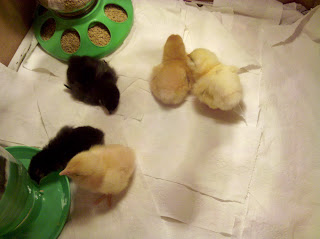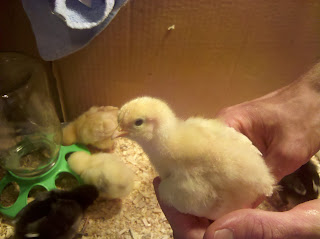In case you've never owned chickens--pasty butt is a common problem with raising baby chicks (excuse the language). It happens when their poop gets stuck to their bottom and hardens. After this, they are blocked and can't poop anymore. It is a deadly condition if not treated!!
 |
| It's important to check baby chicks for pasty butt. |
I watched her after this, and she wouldn't eat or drink. All she would do was lay down to fall asleep--not a good sign. I was scared that she might not survive. I knew that after her pasty butt ordeal, she was probably dehydrated. Since she wouldn't drink on her own, I decided to make her drink. I made a sugar water mixture (1 tsp sugar to 2 cups warm water). I put 1ml into a syringe and fed her the sugar water 1 drop at a time while holding her. It was a slow process (she wasn't interested in drinking) but I got her to swallow quite a bit.
After this, I made her a little infirmary to go in the brooder. It was just a plastic storage container that I put hardware wire over. She had her own little dish of food and water. This had two benefits. First, the other chickens couldn't pick on her and she could rest. Second, by being isolated I could tell if she was eating, drinking, or pooping.
 |
| Chick recovering from pasty butt in an infirmary in the brooder. |
At this point it was late, and I needed to sleep. I put the little buff in her infirmary and hoped for the best. Honestly, I feared that she wouldn't make it through the night. I woke up at 4am to check on her: she was alive, but still lethargic--she HAD pooped though! I went back to bed hoping she would be ok.
At 7am, I woke up to "PEEP!!! PEEP!!! PEEP!!!". The chicks were far from my bedroom, so this chick was really screaming to wake me up. As a good momma hen, I sprung out of bed and ran to the chicks. The little sick buff was jumping up and down in her infirmary INSISTING on being let out. I quickly took the wire off, and she sprung out! And then she ran around saying hello to her friends. I watched her eat and drink.
 |
| The next day she was energetic and playing. |
 |
| Here is 'Sunshine'--1 week after pasty butt. |
 |
| And here is Sunshine as an adult. |












